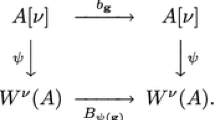Abstract
A parametric model of systems is regarded as a geometric manifold imbedded in the enveloping manifold consisting of all the linear systems. The present paper aims at establishing a new geometrical method and framework for analyzing properties of manifolds of systems. A Riemannian metric and a pair of dual affine connections are introduced to a system manifold. They are calledα-connections. The duality of connections is a new concept in differential geometry. The manifold of all the linear systems isα-flat so that it admits natural and invariantα-divergence measures. Such geometric structures are useful for treating the problems of approximation, identification, and stochastic realization of systems. By using theα-divergences, we solve the problem of approximating a given system by one included in a model. For a sequence ofα-flat nesting models such as AR models and MA models, it is shown that the approximation errors are decomposed additively corresponding to each dimension of the model.
Similar content being viewed by others
References
S. Amari, Differential geometry of curved exponential families—curvatures and information loss,Ann. Statist.,10 (1982), 357–387.
S. Amari, A foundation of information geometry,Electron. Comm. Japan,66 (1983), 1–10.
S. Amari, Differential geometry of systems, Report No. 528, Institute of Mathematical Analysis, Kyoto University, 1984, pp. 235–253.
S. Amari,Differential Geometrical Methods in Statistics, Lecture Notes in Statistics, vol. 28, Springer-Verlag, New York, 1985.
S. Amari, Differential geometry of statistics—towards new developments, inDifferential Geometry in Statistical Inference, IMS Monograph, Institute of Mathematical Statistics, Hayward, CA, 1987.
R. J. Bhansali, The inverse partial correlation function of a time series and its application,J. Multivariate Anal.,13 (1983), 310–327.
P. Bloomfield, An exponential model for the spectrum of a scalar time series,Biometrika,60 (1973), 217–226.
R. W. Brockett, Some geometric questions in the theory of linear systems,IEEE Trans. Automat. Control,21 (1976), 449–455.
R. W. Brockett and P. S. Krishnaprasad, A scaling theory for linear systems,IEEE Trans. Automat. Control,25 (1980), 197–207.
J. P. Burg, Maximum entropy spectral analysis,Proceedings of the 37th Meeting of the Society of Exploration Geophysicists, 1967. Also inModern Spectrum Analysis (D. G. Childers, ed.), IEEE Press, New York, 1978.
C. I. Byrnes, Algebraic and geometric aspects of the analysis of feedback systems, inGeometrical Methods for the Theory of Linear Systems (C. I. Byrnes and C. F. Martin, eds), Reidel, Boston, 1980, pp. 85–124.
N. N. Chentsov,Statistical Decision and Optimal Inference, Nauka, Moscow, 1972 (in Russian); translation in English, American Mathematical Society, Providence, RI, 1982.
D. F. Delchamps, Global structure of families of multivariable linear systems with an application to identification,Math. Systems Theory,18 (1985) 329–380.
P. L. Duren,Theory of H p Spaces, Academic Press, New York, 1970.
E. J. Hannan, Estimating the dimension of a linear system,J. Multivariate Anal.,11 (1981), 459–473.
E. J. Hannan and M. Deistler, Some properties of the parametrization of ARMA systems with unknown order,J. Multivariate Anal.,11 (1981), 474–484.
M. Hazewinkel, Moduli and canonical forms for dynamical systems, II: the topological case,Math. Systems Theory,10 (1977), 363–385.
M. Hazewinkel, (Fine) Moduli (spaces) for linear systems: what are they and what are they good for?, inGeometrical Methods for the Theory of Linear Systems (C. I. Byrens and C. F. Martin, eds), Reidel, Boston, 1980, pp. 125–193.
R. Hermann and C. F. Martin, Applications of algebraic geometry to systems theory: the McMillan degree and Kronecker indices of transfer functions as topological and holomorphic system invariants,SIAM J. Control Optim.,16 (1978), 743–755.
R. W. Johnson and E. Shore, Minimum cross entropy spectral analysis of multiple signals,IEEE Trans. Acoust. Speech Signal Process.,31 (1983), 574–582.
R. E. Kalman, Mathematical description of linear dynamical systems,SIAM J. Control Optim.,1 (1963), 128–151.
W. Klingenberg,Riemmanian Geometry, Walter de Gruyter, Berlin, 1982.
M. Kumon and S. Amari, Geometrical theory of higher-order asymptotics of test, interval estimator and conditional inference,Proc. Roy. Soc. London Ser. A,387 (1983), 429–458.
M. Kumon and S. Amari, Estimation of a structural parameter in the presence of a large number of nuisance parameters,Biometrika,71 (1984), 445–459.
S. Lang,Differentiable Manifolds, Addison-Wesley, Reading, MA, 1972.
S. Lauritzen,Some Differential Geometrical Notions and Their Use in Statistical Theory, IMS Monograph, Institute of Mathematical Statistics, Hayward, CA, 1987.
H. Nagaoka and S. Amari, Differential geometry of smooth families of probability distributions, Technical Report METR 82-7, University of Tokyo, 1982.
C. R. Rao,Linear Statistical Inference and Its Applications, Wiley, New York, 1965.
G. Segal, The topology of spaces of rational functions,Acta Math.,143 (1979), 39–72.
E. Shore, Minimum cross-entropy spectral analysis,IEEE Trans. Acoust. Speech Signal Process.,29 (1981), 230–237.
A. Tannenbaum,Invariance and System Theory: Algebraic and Geometric Aspects, Lecture Notes in Mathematics, vol. 845, Springer-Verlag, New York, 1981.
Author information
Authors and Affiliations
Rights and permissions
About this article
Cite this article
Amari, Si. Differential geometry of a parametric family of invertible linear systems—Riemannian metric, dual affine connections, and divergence. Math. Systems Theory 20, 53–82 (1987). https://doi.org/10.1007/BF01692059
Received:
Accepted:
Issue Date:
DOI: https://doi.org/10.1007/BF01692059



